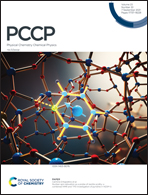Effects of ligands on (de-)enhancement of plasmonic excitations of silver, gold and bimetallic nanoclusters: TD-DFT+TB calculations†
Abstract
Metal nanoclusters can be synthesized in various sizes and shapes and are typically protected with ligands to stabilize them. These ligands can also be used to tune the plasmonic properties of the clusters as the absorption spectrum of a protected cluster can be significantly altered compared to the bare cluster. In this paper, we computationally investigate the influence of thiolate ligands on the plasmonic intensity for silver, gold and alloy clusters. Using time-dependent density functional theory with tight-binding approximations, TD-DFT+TB, we show that this level of theory can reproduce the broad experimental spectra of Au144(SR)60 and Ag53Au91(SR)60 (R = CH3) compounds with satisfactory agreement. As TD-DFT+TB does not depend on atom-type parameters we were able to apply this approach on large ligand-protected clusters with various compositions. With these calculations we predict that the effect of ligands on the absorption can be a quenching as well as an enhancement. We furthermore show that it is possible to unambiguously identify the plasmonic peaks by the scaled Coulomb kernel technique and explain the influence of ligands on the intensity (de-)enhancement by analyzing the plasmonic excitations in terms of the dominant orbital contributions.



 Please wait while we load your content...
Please wait while we load your content...